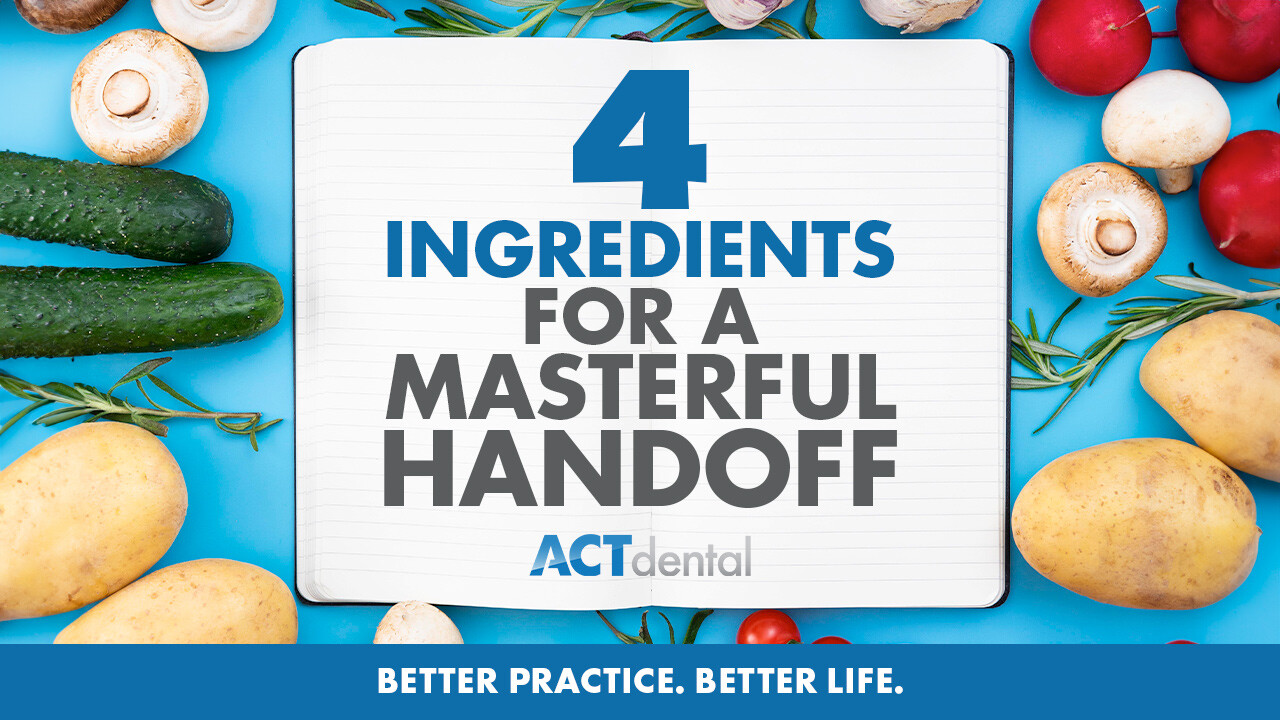The hand-off is a simple concept in practice, but it has a huge impact on your practice. At its most basic, it’s just a verbal transfer of information, but it elevates your customer service by making patients feel safe and important. Like Kirk says, you want a practice that’s “relational, not transactional.” Furthermore, it brings clarity and efficiency to your team, helping to create a well-oiled machine. It happens any time there’s a transition from one team member to another, which will happen countless times. As a result, it’s critical to master the concept, and the best way to do it is to create a hand-off system.
I like to think of a hand-off as something that has a recipe, so in order to maximize your hand-off, make sure you have its four ingredients:
- What did we do today?
- What did we discover together?
- What’s next? (and bonus, how will it benefit the patient)
- What do I need from you?
To demonstrate how to use these concepts, I want to use the example of a hand-off to a business team member:
- What did we do? “We completed hygiene services and it went great!”
- What did we discover together? “We noticed decay on the patient’s upper left that she’s very concerned about.”
- What’s next? “The doctor recommends a crown, and the patient really wants to avoid emergencies so she is eager to move forward.”
- What do I need from you? “Before she reserves time, she needs to get more information on the investment. Would you be able to give her the information and reserve time with the Dr.?”
Whether it’s a hand-off to the doctor, the chairside assistants, or the admin team, the steps are always the same. However, just like with any recipe, you can make little adjustments here and there. For the admin team, I like to include a component that goes hand-in-hand with the discovery aspect of the visit: Why is this treatment important to the patient? After all, both the doctor and the business team need to know the patient’s primary motivating factor. Otherwise, how are we to answer any possible objections the patient may have to the treatment?
It’s so simple, and it shows your patients that you’re listening, which reduces uncertainty and increases trust. As a result, you’re going to see your treatment acceptance increase. Remember, practice makes perfect, so don’t be afraid to come together as a team and engage in some skills practice! That way, you’ll be ready for your patients and knock your interactions out of the park! As always, if you have questions, are looking for help, or simply want to learn more about what ACT has to offer, reach out to Gina!
Michelle Wakeman
Michelle Wakeman, BSDH brings nearly 20 years of clinical dental hygiene, administrative, managerial and sales experience to the table. She has a passion for people and a natural aptitude for communication that has led her to develop meaningful relationships throughout her career in dentistry. As a coach, she seeks to help dental practices develop systems that enable them to enhance their patient experience, leading to better relationships among owners, team members and patients along with profitable outcomes. In her off time, Michelle can usually be found at the ice rink supporting her son, Hunter in hockey, the ball field cheering on her son, Carter, or the gym, reliving her days as a gymnast with her daughter, Leighton.
RECENT POSTS
Evaluate Your Year with Intention
December 19, 2025
984: How to Address Chronic Attendance Issues – Alan Twigg
December 19, 2025
983: 2 Things You Must Do in 2026 to Improve Your Reimbursements – Shelley DeGroff
December 17, 2025
Real Practices. Real Progress. Real Proof. - A Year Worth Celebrating
December 15, 2025
Solve the 5 Problems that Overwhelm Your Team
December 12, 2025
981: Leadership Lessons for Thriving Practices – Michelle Wakeman
December 11, 2025
980: This Year, Take Back Control: Protect Your Practice. Reclaim Your Life – Miranda Beeson
December 10, 2025
Is Your Practice Stuck On The Wrong Side Of The Bridge?
December 08, 2025
